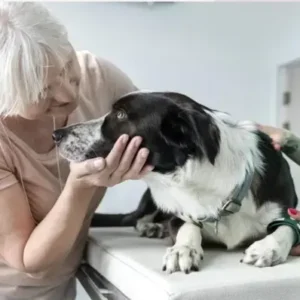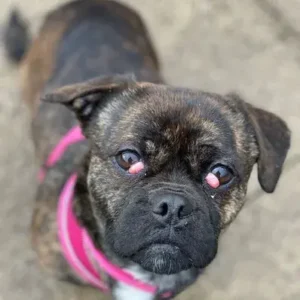Types of Yeast Infections in Dogs
Yeast infections can develop in various parts of a dog’s body, including the ears, skin folds, paws, armpits, vulva, and groin.
Here’s a closer look at each type:
Ears (Yeast Otitis)
Yeast infections in the ears, known as yeast otitis, are characterized by a thick, brown discharge and a strong, unpleasant odor from the ear canal. Dogs with this condition often scratch their ears excessively to relieve discomfort, shake their heads frequently, or even develop a head tilt.
These infections are often associated with food allergies and are more common in breeds with long, floppy ears.
Skin (Yeast Dermatitis)
Yeast dermatitis refers to a yeast infection that affects the skin caused by Malassezia pachydermatis.
Dogs with this condition may have:
- A musty odor.
- A greasy coat.
- Flaky or thickened skin.
- Hair loss in affected areas.
They often lick the infected areas repeatedly, leading to brown skin discoloration over time. Yeast dermatitis is typically linked to allergies or a weakened immune system and commonly occurs in areas like skin folds, armpits, vulva, and groin.
Paws
Yeast infections on the paws are usually caused by environmental allergens, such as grass or pollen. Affected dogs often chew or lick their paws constantly, leading to brown discoloration between the paw pads. If untreated, the constant irritation can result in open sores or wounds on the paws.
By recognizing the types of yeast infections and their symptoms, you can better understand what to watch for. This helps you take timely action to relieve your dog’s discomfort.
Causes of Yeast Infections in Dogs
Several factors can contribute to yeast infections in dogs:
- Allergies: Food sensitivities, environmental allergens, or flea bites can trigger skin inflammation, creating the perfect environment for yeast overgrowth.
- Weakened Immune System: A dog with a compromised immune system is less able to keep yeast levels in check.
- Excess Moisture: Dogs who swim frequently or have floppy ears that trap moisture are at higher risk.
- Medications: Prolonged use of antibiotics or steroids can disrupt the natural balance of microorganisms, allowing yeast to thrive.
Signs and Symptoms
Yeast, bacteria, and fungi naturally live on your dog’s skin, but under normal conditions, they don’t cause any health problems or bacterial infections.
The symptoms of a yeast infection can vary depending on the location but often include:
- Red, inflamed, or irritated skin.
- Persistent scratching or paw licking.
- A foul or “yeasty” odor, particularly in the ears.
- Hair loss, greasy patches, or flaky skin.
- Dark brown or yellowish discharge in the ears.
If you notice any of these signs, it’s essential to consult a veterinarian for a proper diagnosis.
What Dog Breeds Are Prone to Yeast Infections?
While any dog can develop a yeast infection, certain breeds are more susceptible due to their physical characteristics or underlying health conditions. Breeds with excess skin folds, floppy ears, hair growing inside the ear canal, or a tendency for allergies are at a higher risk.
Affected dog breeds include:
- Shih Tzu
- Cocker Spaniel
- Standard Schnauzer
- Golden Retriever
- Labrador Retriever
- Basset Hound
- West Highland White Terrier
- German Shepherd
- Boxer
- Maltese
- Dachshund
- Poodle
Diagnosis
A yeast infection may look similar to other skin conditions, so accurate diagnosis is crucial. Your veterinarian may perform:
- Skin Scrapings: Collecting skin cells for microscopic examination.
- Cytology: Studying cells from the affected area under a microscope.
- Culture Tests: Identifying the specific strain of yeast to ensure effective treatment.
Treatment For Yeast Infection
Treating a yeast infection often involves a combination of approaches:
- Topical Treatments: Antifungal medicated shampoos, creams, ear drops, or sprays can directly target yeast overgrowth. Ingredients like miconazole or ketoconazole are commonly used.
- Oral Medications: Severe or widespread infections may require prescription antifungals such as fluconazole or itraconazole.
- Dietary Adjustments: A low-carbohydrate diet can help starve the yeast, as it thrives on sugars. Anti-inflammatory foods may also reduce skin irritation.
- Home Remedies (with vet approval): Diluted apple cider vinegar or coconut oil can be soothing for mild infections.
Preventive Measures
Prevention is always better than cure. To minimize the risk of yeast infections:
- Groom your dog regularly and keep their skin folds and ears clean and dry.
- Dry your dog thoroughly after baths or swimming.
- Address allergies promptly to reduce skin inflammation.
- Provide a well-balanced diet to support the dog’s immune system.
Home Remedies to Help Prevent Yeast Infections in Dogs
Preventing yeast infections involves good hygiene and proactive care. Always consult your vet before trying new remedies.
- Clean and Dry Ears: Use a vet-approved ear cleanser and keep ears dry after bathing or swimming.
- Apple Cider Vinegar Rinse (Diluted): Mix equal parts vinegar and water for a natural antifungal rinse for paws or skin folds.
- Coconut Oil: Apply a thin layer to soothe skin and reduce fungal growth.
- Balanced Diet: Feed a low-carb diet and add probiotics to support immune health.
- Regular Grooming: Trim hair around ears and paws and brush regularly to prevent mats and irritation.
- Manage Allergies: Address food or environmental allergies to reduce skin inflammation.
Simple care routines like these can help keep yeast infections at bay and improve your dog’s overall health.
When to See a Veterinarian
For chronic yeast infection or worsening symptoms despite home care, it’s time to consult a veterinarian. Signs such as severe pain, swelling, or a lack of response to treatments indicate the need for professional intervention.








